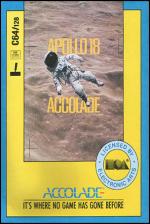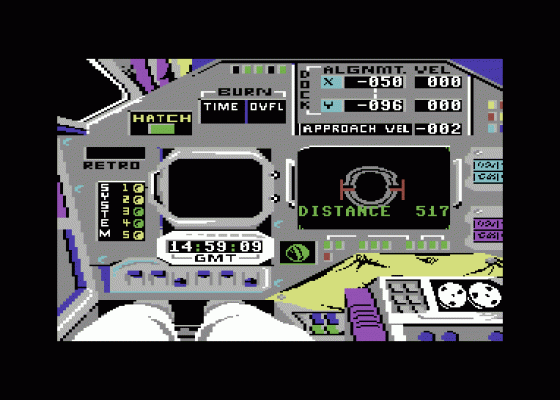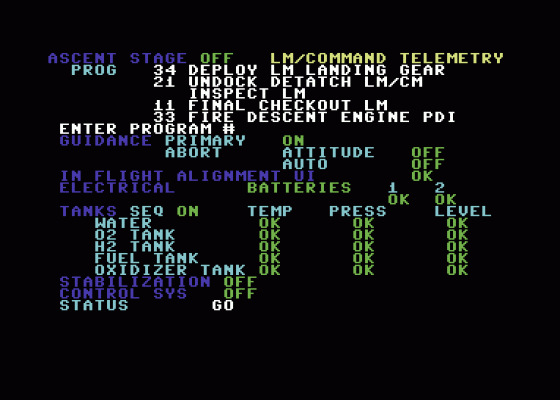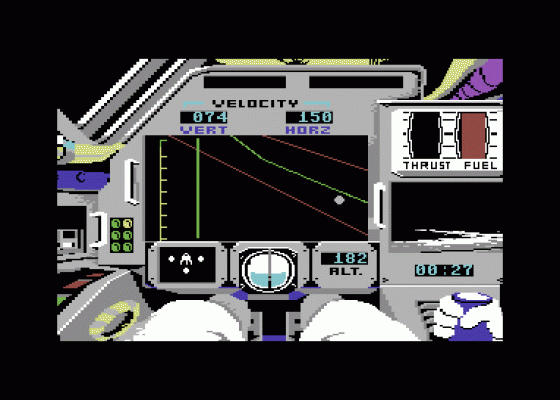
Commodore User
 1st March 1988
1st March 1988
Categories: Review: Software
Author: Mark Patterson
Publisher: Accolade
Machine: Commodore 64/128
Published in Commodore User #54
Apollo 18
In 1961 President John F. Kennedy gave NASA the task of landing a man on the moon and returning him safely to Earth. Seven years later, American astronaut Neil Armstrong descended the ladder from his lunar module and, with the now immortal words, "one small step for man, one giant leap for mankind", he became first man to land on the moon. Now with Apollo 18 it's your turn.
So yours truly, the reject from the right stuff, donned with his white EVA suit and helmet and prepared for launch. The disc drive whirred and clunked a bit then the telly said "Apollo 18 ready for launch". Following this, there were some nice pictures, more speech, and finally the game! I pressed the button to start. The computer told me to proceed to telemetry, whatever that was. So back to the instructions. The telemetry screen is like the interlude screen which occurs between most of the missions where you have to switch on bits of your rocket in order not to fry yourself or your crew. Also, at later stages, you are required to enter a specific program number for the in-flight computer to run. So I switched everything on and went back to the launch screen.
The concept for the launch screen is original, but distracts you from all the pretty graphics going on. The display for the level shows half of the screen as instrumentation, the other half the paranoid boffins in the mission control room. In the centre of the room is the view screen which shows your rocket launching at various levels of closeness, and very effective it is too.

When you execute the launch you get more speech telling you the countdown has started and the boosters have been switched on. To control the functions like activating the boosters and ejecting spent rocket stages, there is a small gauge. Every now and again a red bar appears which darts to the other side, you have to press the fire button and stop the bar as close to the line at the centre of the gauge as possible. If you stop the bar too far away from the line, the launch will be aborted.
You have to do this four times for each stage of the rocket, but on the second stages and above you have a set of left/right giros to control as well. If you let these overshoot more than three times, the launch will again be aborted. This may sound easy, but trying to keep a close eye on to sets of gauges while watching the pretty graphic effects and keeping an ear open for the excellent speech is no mean feat.
If you manage to make it out of the Earth's atmosphere, the display changes to that of inside the cockpit, with your legs sticking out the bottom of the screen surrounded by various controls and readouts, with a monitor screen to the right. Then you have to dock with an orbiting space station. To do this you have to run the programs through the telemetry screen, then line up the crosshairs on the small display screen with the target space station. Get it right, go slowly enough and you'll fly straight into the docking area.
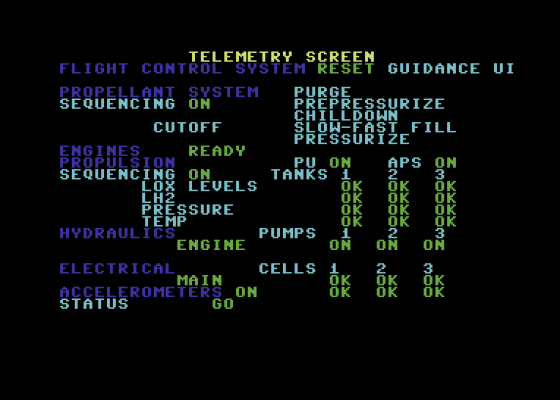
The next stage is the in-flight course corrections. This is a wee bitty boring, just wait for the countdown to finish then hold down the fire button until some numbers on a display in the top left of the screen start whirring round, then release. Nothing to it really.
The next stage is to land on the moon. This is rather tricky. You have to guide the lunar module down via a map display. To manoeuvre you have to fire the control rockets in the opposite direction to which you want to go. So to go right you need to pull left and to go left you need to pull right. Then, when you get into a satisfactory position, you have to put on the brakes to slow down enough to land. This all may sound easy, but you only get three attempts.
After landing comes the moonwalk. You have to reach the Surveyor III and get back to your lander again without running out of oxygen. You pull right on the joystick to pick up speed, and left on the joystick to lean back when you complete one of those funny little jumps. To correct any deviations in your course you can pull up and down on the joystick.

Once you're back in space, your penultimate mission is to practise grabbing satellites for repair. You start this mission by pressing fire to release the first satellite. Your outer-space fumblings will be recorded on one of three different cameras. To grab the satellite, you have to be in exactly the same dimension as it. What I mean is that the stage is played in three dimensions; you can move in and out by using the cursor keys, and you can jet pack around. To aid you, there is a special motion tracker, which is very fiddly to use. When you are level with a satellite you must be facing it and be travelling really slowly in order to activate your space hook and grab it. This is the only mission I didn't like, as I found it tedious and too taxing on the mental resources of a weary astronaut.
Finally, there is the re-entry. After activating about a half dozen programs, you have to complete the task of keeping a crosswire centre on a round ball. Sounds interesting, doesn't it? In fact, it is pretty hard, as the further from the centre you get, the further off course you go and the hotter it gets. If the temperature exceeds five-thousand degrees, you and your men fry.
When you complete a mission you are given several neat high-res screens and a lot of speech. If you're lucky you would have splashed down perfectly to the American national anthem, or to mission control saying "You're way off course, Apollo". Either way, it's still good.
Apollo 18 is a really great game, it actually feels good to play. The graphics are good with lots of extra touches and special effects here and there which really spice it up. The sound is pretty remarkable, the effects are good, but the speech can't be faulted either. It's not that the speech is very high quality (I don't know whether it's bad in that it's intended to sound like it's really being broadcast across millions of miles) but there is loads of it. A highly entertaining piece of software which I really liked, not only original but enjoyable too. Definitely one for all you budding Kirks out there.

